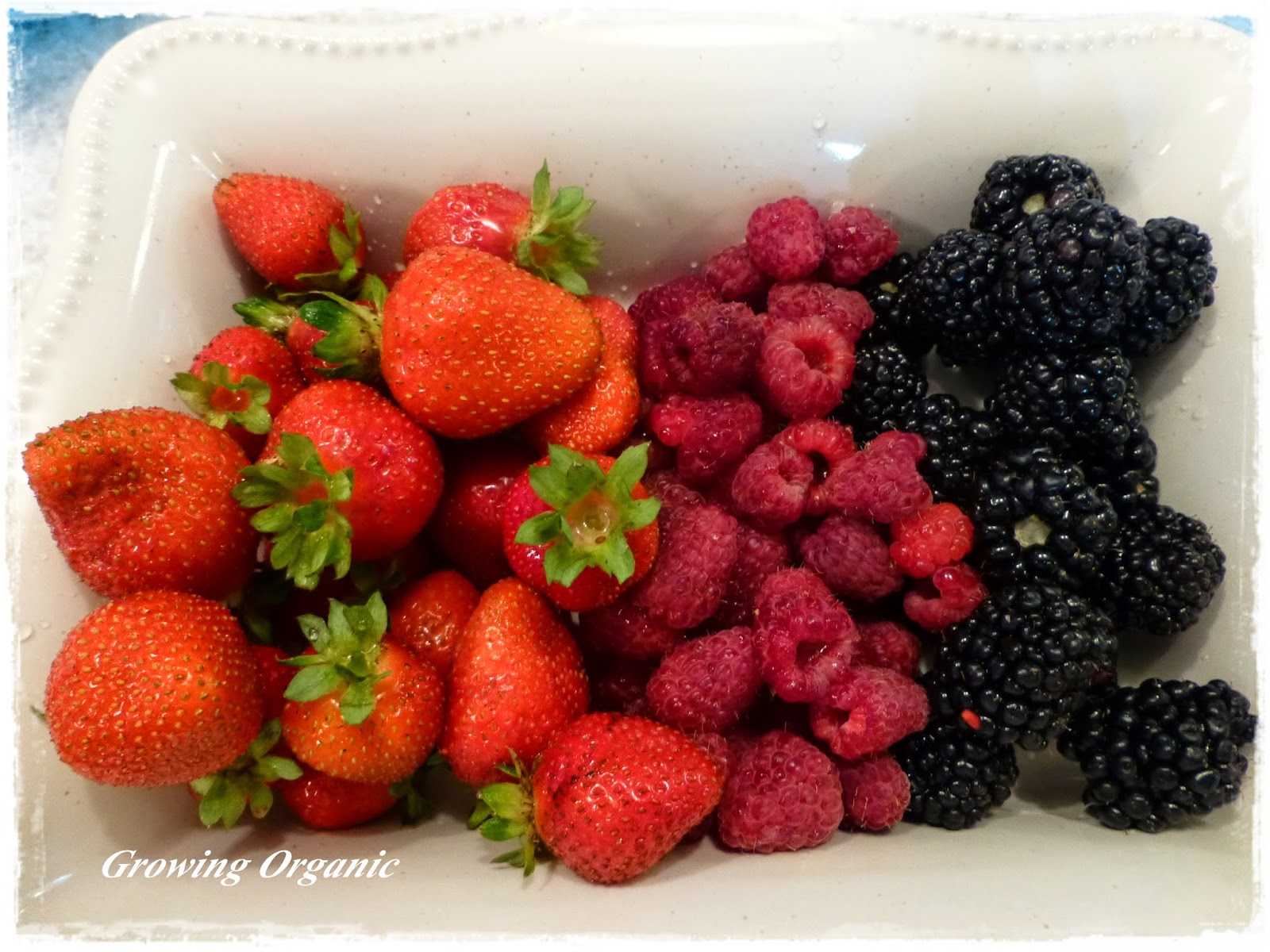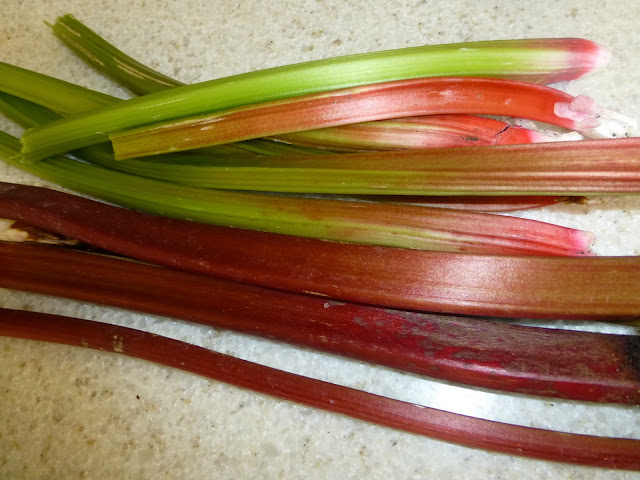Nothing is better than a cane ripened blackberry or raspberry. They are incredibly sweet! Store bought fruit is picked before it is ripe because is it firmer and handles shipping better. It is sour because it was not allowed to ripen on the cane. Store bought berries are also expensive. It is definitely worth the investment and effort to grow your own berries. They are highly nutritious, easy to grow, delicious, and have many options for preserving.
Blackberries and raspberries are brambles. They are made up of a small group of fruit called aggregates that adhere to a receptacle. One of the differences between blackberries and raspberries is that raspberries pick free of the receptacle and blackberries retain the receptacle when picked.
 |
| Blackberries which grow on lateral shoots. |
General Guidelines for Brambles
Brambles like full sun and protection from wind. They need soil with good drainage and lots of organic matter. Avoid clay and areas where they will have "wet feet" or standing water.
Both raspberries and blackberries will spread and propagate. Raspberries send up new canes and are vigorous and invasive. I recommend planting in 2 foot wide boxes or within a cement area. A two foot wide planting area allows you to pick berries easily from both sides.
Blackberries while not quit as troublesome to contain as raspberries also send up new canes and will tip propagate also. Both will also need some kind of trellis. With erect blackberries, you can get by without a trellis but it is nice to have something to tie the canes to so the berries do not touch the ground.
I also highly recommend purchasing certified virus free plants to start your bramble patch. Although tempting to get starts from your neighbor, you may be bringing diseased plants into your garden. I also like bare root starts. Bare roots come to you dormant and with no soil around the roots. Obtain these in early spring. Bare root starts seem to be healthier and more productive than container plants and you also have more options in varieties. I have had good success with these nurseries: Raintree, Miller, and Jung.
Establishing a Bramble Patch
Preparing the Site
- In choosing your site, do not plant where strawberries, tomatoes, peppers or potatoes have been planted within the last 5 years.
- Plant in rows no wide than 3 feet. This allows for easy harvesting, pruning, and watering.
- Place raspberries 2-3 feet apart.
- Place blackberries 4-5 feet apart
- Before planting incorporate organic compost into the soil. Also add some complete dry organic fertilizer
- Build your trellis
Planting
- When you receive the raspberry bare roots stock, open it up and moisten it.
- If you are not ready to plant you must keep the plants cool and moist
- When you are ready to plant place the roots in a bucket of water and avoid exposing the roots to direct sunlight
- Plant the crown just below the soil level
- Bare roots have one short cane called the handle. This will not leaf out. New canes come up around the handle.
- Keep the soil evenly moist and mulch around your berries.
Maintenance of Brambles
- Keep rows or boxes weeded
- Prune in early spring
- After pruning and while dormant, spray with a dormant spray to smoother pest eggs.
- Apply dry organic fertilizer in early spring
- Add a layer or 1-2" of organic matter around canes
- When buds break and at flowering ferilize with fish emulsion and sea kelp. Fish emulsion is applied in a watering can around roots and kelp is used as a foliar spray
Blackberries
Blackberries are a member of the rose family along with raspberries, strawberries, apples, and peaches. A very delicious plant family.
Blackberry stems are called canes. The roots are perennial meaning they live for years. The canes, however, are biennial meaning they live only two years. The roots send up new canes every year. Why is this important to know? In order to have productive harvests and large berries you need to prune blackberries properly. To do this you need to understand what is going on with the canes.
The first year canes are called primocanes. They do not bear fruit the first year. The job is simply to grow vegetatively which they do quickly and aggressively. The second year canes are called floracanes. They are the canes that will flower and bear fruit. During the fall and winter they will die having completed the cycle, but remember the root also send up new primocanes every year which will provide you with fruit the following year.
Sound confusing? Just remember the canes live two years. They grow the first and bear fruit the second. If left unpruned they will not be as productive. We prune to encourage fruiting and tame the growth of the canes. They can grow 15ft in the first year, but that growth does not encourage more berry production.
Sounds simple until you go outside and look at the mass of canes. So to review the process.
- Cut all dead canes to the ground
- Cut all canes to a height of 5-6 feet and tie to a trellis this stimulates lateral can growth
- The lateral canes come off the main cane they must be pruned to 18-24 inches or 12 buds
- All cuts should be made to just above an existing bud.
- Cut out all weak and diseased canes.
- Clean out leaf litter from around canes.
- Sprinkle dry fertilizer around canes
- Spread a layer of mulch around.
Newly Planted
- When canes reach 5-6 feet tip off canes.
- This is usually done in July
- This encourages lateral shoots which are where fruit will be borne next year.
- New primo canes will come ups from crown of the plant
- Prune to the ground all canes the bore fruit
- Burn or take the pruned canes to the dump
- Thine remaining primocanes to about 7 -12 per plant
- Do not prune out flora canes
- Prune lateral branches on main canes to 12 buds
- Tie the pruned canes to your trellis
All Blackberries:
- Clean up leaf litter around plants after pruning
- Sprinkle a complete dry organic fertilizer around base of canes.
- Add 1-2" of compost around base of canes.
- Spray with a dormant oil when nighttime temperature is in 40's.
 |
| Blackberries needing pruning. |
 |
| Pruned blackberries |
Types of Blackberries
Erect varieties do not require trellising. They are very cold hardy. Good varieties are Arapaho, Apache, and Navajo. I like these varieties best for my planting zone. They are easy to maintain and very productive.
Semi-Erect varieties need a trellis and are less cold hardy. Suggested varieties include Black Satin, Triple Crown and Chester. I do like Triple Crown I have not tried the others
Trailing varieties are tender and require winter protection.
Harvesting Blackberries
- The color of the berry will develop before the flavor. Resist picking early. It's worth the wait.
- Immature fruit will be shiny black
- Mature, sweet fruit will be a dull black
- The mature fruit separates easily from the plant
- Pick mature for fresh eating and slightly immature for canning
- Berries can easily be individually frozen and then placed in ziploc bags.
Raspberries
Raspberries are very cold hardy and aggressive plants. The roots spread out laterally 3-4 feet in all directions. Buds are randomly produced along the root from fall the spring. The canes from these buds will easily reach 6 foot in length.
Raspberries fruit from the tip and on down the cane. The last two or three buds below the ground remain vegetative and will produce the primocane the following season
Raspberries are one plant you do not want to neglect. As I said before they are best planted in raised beds no wider that 2 feet and must be pruned to control growth and keep up berry production.
Types of Raspberries
Summer Bearing
Summer Bearing produce one large crop in late summer or early fall. They can be further categorized as early bearing, mid season, or late bearing. The harvest period will last about 4 weeks. Popular varieties include, Canby, Latham, Taylor and Kilearney. I had Taylor and Kilearney but the everbearing Caroline are by far my favorite. The taste of summer bearing is very good but production is low and the berries are not as big.
Pruning Summer Bearers:
- Prune in early spring before bud break
- Cut all dead canes that bore fruit last year out to the ground
- Thin out spindly weak canes and those outside the growing area
- Thin out canes to 10-12 per square foot leaving healthiest canes
- Top canes off at 5' to induce lateral shoots where fruit will be produced
Everbearing raspberries generally have 2 harvests per season; one in mid-late summer and one in the fall. Varieties I like include Polka, Meeker, Caroline, and Anne. I highly recommend Caroline, Polka, and Meeker. They are very productive, vigorous, and produce large berries. The primocanes of ever bearers will bear fruit on the tip the first year, and the 2nd year produce fruit below the tip.
Everbearing raspberries generally have 2 harvests per season; one in mid-late summer and one in the fall. Varieties I like include Polka, Meeker, Caroline, and Anne. I highly recommend Caroline, Polka, and Meeker. They are very productive, vigorous, and produce large berries. The primocanes of ever bearers will bear fruit on the tip the first year, and the 2nd year produce fruit below the tip.
Pruning Everbearer:
- Prune in early spring before bud break
- On primocanes that bore on the tip, prune just below the tip that bore. Prune 1/4 inch above a healthy bud
- Prune out all dead canes.
- Thin out spindly weak canes and those outside the growing area
- Thin out canes to 10-12 per square foot leaving healthiest canes
- Top canes off at 5' to induce lateral shoots where fruit will be produced
All Types of Raspberries:
- Clean up leaf litter around plants after pruning
- Sprinkle a complete dry organic fertilizer around base of canes.
- Add 1-2" of compost around base of canes.
- Spray with a dormant oil when nighttime temperature is in 40's.























